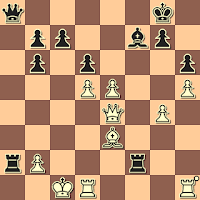"Cliff Hardy" has lit up the chessboard again with a 1 0 Jerome Gambit game that highlights the rapid ups and downs - and eventual up - that come with playing a "refuted" opening.
Below is the game, with notes by Cliff, and an occasional diagram (and note, in blue) by me - Rick.
Hardy, Cliff - NN
1 0 lightning, lichess.org, 2018
1.e4 e5 2.Nf3 Nc6 3.Bc4 Bc5
Lichess has a new "Opening explorer & tablebase" feature, which reveals that 12,217 games in its database have reached this position.
4.Bxf7+
But, interestingly, zero games in its database have reached this position!
(By the way, since those of us who play the Jerome live in an alternate reality - where, in contrast to the lichess database, our opponents do occasionally play 4...Kf8 - I checked the move out in "our" The Database and found 281 games. A bit puzzlingly, white scores only 55%. Of course, that reflects a bit on who actually is playing the game [we are mostly club players] - remember, The Database also says White scores only in the mid 40s with 1.e4 e5 2.Nf3 Nc6 3.Bc4 Bc5 4.Bxf7+ to begin with. YMMV. - Rick)
4...Kf8!?
Unsurprisingly, Stockfish is not a fan of this innovation and says that White has a winning advantage now.
5.Bxg8?!
Keeping the bishop with 5.Bb3 made a bit more sense but I was a little flustered by his last move!
5...Kxg8 6.c3 d6 7. d4 exd4 8. cxd4 Bb6
9.Be3 Bg4 10.h3?
10.Qb3+ was better, I had missed that after 10.h3 (as played in the game) 10...Bxf3! I would have to double my pawns with 11.gxf3.
(To redo David Foster Wallace's lament, "Move in haste, annotate at leisure." Remember, this is a 1-minute game - Rick)
10...Bh5? 11.Nc3 h6 12.g4 Bg6
13.Qb3+?
Stockfish prefers to simplify by getting pieces off with 13.d5.
13...Kh7?
13...Bf7 was a much more active defence.
14.O-O-O?
Allows Black equality but 14.h4!, intending to push the bishop on g6 back with 15.h5 or to attack Black's king with 15.Ng5!+ hxg5 16.hxg5+, would have led to White retaining his winning advantage.
14...Rf8?
White is now winning again but 14...Qf6! would have equalised as White could then not have saved both his knight on f3 and pawn on d4.
15.Ne1 Qf6 16.Nd5 Qd8 17.Nxb6??
This allows 17...cxb6!, opening the c-file to attack White's king, and surprisingly yields him a winning advantage; whereas 17.f3 would have been a solidifying strong move for White.
17...axb6? 18.f3 Bf7 19.Qc2??
Losing the pawn on a2 is disastrous for white but, of course, 19.d5 would have been strong for me.
(Ah, but a private eye often runs into serious danger before solving his case - Rick)
19...Rxa2 20.Nd3 Qa8 21.d5 Ne7 22.Nf4 Ng6 23.Nxg6 Bxg6 24.h4??
White could at least have held on to his f-pawn with 23.Rhf1, though White would still have been completely lost, since the white king would still have been too vulnerable.
24...Rxf3 25.h5 Bf7 26.e5+ Kg8 27.Qe4 Rf2??
Whoops! He couldn't notice in time that g3 was the only square available for the rook e.g. 27...Rg3 28.Bf2 Rxb2! 29.Kxb2 (29.Bxg3 Qa1+ checkmates) 29...Qa3+ 30.Kc2 Qa2+ 31.Kc1 Rc3+ 32.Qc2 R/Qxc2 checkmate.
(Each player has averaged about 2 seconds of thinking time per move - they were in "time trouble" from the first move, and it is impressive how well they have done. Ah, but as the game gets closer to flag fall, things get dicier - Rick)
28.Bxf2 Ra1+ 29.Kc2 Ra2 30.e6 Be8 31.Bd4 Ba4+ 32.Kc3
Bxd1 33.Rxd1 Qa5+ 34.Kd3
34..Rxb2??
OK lol, it is apparent that we were in (more) time trouble here, since 34.Bxb2 was possible, but Black is lost in any case.
35.Ke3 Qa3+ 36.Kf4 Rb4 37.Qf5??
Amazingly, after this move, Black could have forced a perpetual check with 37...Rxd4+! 38. Rxd4 Qc1+ e.g. 39.Ke4 Qe1+ 40.Kf4 Qf1+ 41.Ke3 Qe1+; whereas if 37.e7 had been played, White could have won in just a few moves.
37...Qh3 38.Qf7+ Kh8 39.Qxg7 checkmate











No comments:
Post a Comment